Archive for the ‘Side’ Category
Wednesday, February 24th, 2010
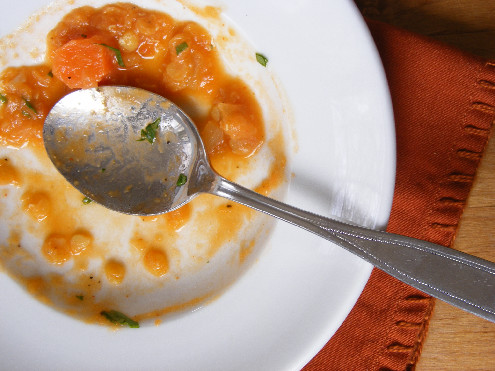
This red lentil soup is comfort food.
It takes the edge off a cold, winter day and satiates my panza (belly).
It’s a souped-up tomato soup – made hearty with red lentils and flavorful with my favorite warming spices: ginger, cumin and chile. Several Ethiopian red lentil dishes are similar; this one is more simple.
Last month, I made a jumbo batch for a New Year’s snowshoe group outing. It was a crowd pleaser. After trekking steep hills in gusty winds at 11,000 ft., we huddled near a fire pit warming cold fingers and toes. And, we grubbed! Hot chocolate, hot ginger tea, home-made sweets, grilled spicy sausage on sticks and, yes, red lentil soup. It was a wonderful way to start the New Year – outdoors, warm and belly full.
Red lentils cook faster than other lentils because they are hulled. Although they are referred to as red, they are actually a salmon pink hue. When cooked, the discs turn golden and are delicate, which makes them well-suited for purées or soups.
This lentil soup is a filling main course especially when served with crusty bread. It’s also a nutritious side dish with a sandwich (or sausage on a stick).
Tidbits on Lentils:
- Lentils’ botanical name Lens culinaris means cooking lens, a reference to its convex shape.
- Up until the later part of the last century, lentils and other beans were generally stigmatized as peasant food – they were staples to those who could not afford meat. However, in places like Egypt, there were aficionados who were particularly fond of red lentils. In India, where vegetarianism was prominent, lentils were also integral to diet.
Source: Beans: A History by Ken Albala
(more…)
Print & If you liked this post, please share:
Tags: budget, cheap eats, comfort food, ethiopian, history, recipe
Posted in African, Gluten-free, Lentil, Main, Side, Soup - Stew, Tomato, Vegetarian | 3 Comments »
Wednesday, February 17th, 2010

Growing up Catholic, lentils were standard in my house every Lenten season. Now, as an adult, I eat them year-round but more frequently during the colder months in hearty soups and other comforting dishes. Although some of you may be scrunching your nose about now, don’t. They make for good eating. Yes, lentils prepared inadequately can be boring and flavorless – perhaps why they get associated with deprivation. But, spiced right, they are oh so scrumptious and uber healthy.
For inspiration on cooking lentils, I look toward India, Pakistan and other countries in the Indian subcontinent, where lentils are integral to diet and dal.
Simply speaking, a dal (also spelled dahl, daal or daahl depending on the specific region) is a stew made from legumes such as lentils and is typically seasoned with turmeric, ginger, and other spices. It is enjoyed with roti (flatbread), fragrant basmati rice, and vegetables.
Traditional dal requires making lentils from scratch. Even though they cook relatively fast compared to other legumes, we’re keeping it simple. Pre-made lentils and a handful of other ingredients (that are likely in your pantry) are all that is needed. This easy recipe is a healthy go-to-meal for those nights when you want something home-made but don’t want to spend hours in the kitchen. It takes about 15 minutes to prepare.
Try this dish as an alternative for a Lenten Friday meal or, if you’re like me, anytime.
Tidbits on Lentils:
- Lentils are believed to have originated from Eastern Turkey and Northern Syria and are thought to be one of the first crops cultivated by man. They have been a food source for over 8000 years, although wild lentils, dating back 11,000 years, have also been found in a Greek cave.
- There are at least 50 cultivated varieties of lentils that come in various forms (split versus whole), various sizes, and an array of colors including yellow, red, green, brown and black.
- Lentils are often considered a good substitute for meat and have gained popularity as a Lenten food. These legumes are a good source of lean protein. They are a complete protein paired with grains, nuts, seeds, eggs and dairy products.
(more…)
Print & If you liked this post, please share:
Tags: dahl, history, india, indian, lent, lenten, origin, recipe
Posted in East Indian, easy, Lentil, Main, Side, Soup - Stew, Vegetarian | 57 Comments »
Tuesday, December 29th, 2009
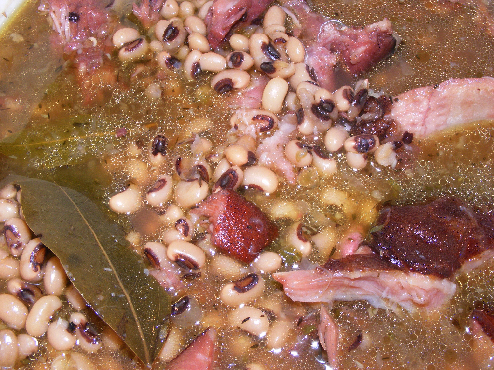
Get ready for the hoopla – banging pots and pans, fireworks, and even firearms shooting off. Yikes! These are just a few of the ways people around the world welcome in the New Year. Originally, these loud rituals were believed to frighten away bad spirits and ensure a good year to come. Me, I’ll be doing something a bit more tame – cooking up a pot of black eyed peas.
 Eating black eyed peas on New Year’s Day is a longtime custom among African Americans and Southerners who believe the legumes will bring prosperity and good luck, especially when paired with greens, which symbolize money. Some folks say you just need to eat a spoonful and others say at least 365 (one for each day of the year). Regardless, this year, in this economy, the superstitious dare not skip this tradition.
Eating black eyed peas on New Year’s Day is a longtime custom among African Americans and Southerners who believe the legumes will bring prosperity and good luck, especially when paired with greens, which symbolize money. Some folks say you just need to eat a spoonful and others say at least 365 (one for each day of the year). Regardless, this year, in this economy, the superstitious dare not skip this tradition.
Some prefer to get their good fortune via a rice and black eyed pea dish called Hoppin’ John. I, however, prefer my peas simmered for several hours until they become creamy. That’s how my in-laws cook them up and how I’ve been eating them for almost two decades. They make a delicious meal served with a dash of Louisiana style hot sauce and maybe some vinegar, along with a generous portion of greens and big ‘ole slice of corn bread.
Black eyed peas can be found in most markets, either dried (found with other legumes), frozen or canned. If you have the time, make them from scratch with this recipe. There really is no substitute. But, if you cannot, opt for the frozen over the canned.
Happy New Year! Below are a few more New Year’s traditions that might pique your interest. Let me know if you have any to share.
Other New Year’s Rituals:
- Good luck will follow to couples who feed each other grapes during the last 12 seconds of the year. Feed your love interest 12 grapes, representing 12 months in the year; one with each stroke of the countdown and make a wish (Spain and Latin American countries).
- In you want to travel in the New Year, take your luggage outside and walk around at midnight (Mexico).
- Eat round-shaped foods such as grapes and prepared desserts for luck; eat noodles for a long life (Philippines).
- Wear red underwear at midnight for luck with love in the upcoming year or yellow underwear for luck with money (Mexico).
- For those who are thrill seekers, plunge into icy waters for a polar bear swim on New Year’s Day (Canada).
(more…)
Print & If you liked this post, please share:
Tags: New Year's tradition
Posted in Black eyed peas, holiday, Main, Side, Soul Food, Soup - Stew, Southern | 4 Comments »
Wednesday, December 9th, 2009
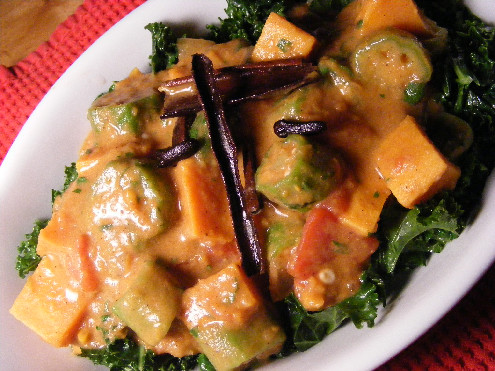
What kind of sweet potato person are you? A. Eat sweet potatoes at Thanksgiving meal and don’t eat them otherwise; B. Eat sweet potatoes year round; C. Don’t eat sweet potatoes. I predict most folks fall into the holiday eater group and these lovely tubers get ignored the rest of the year. What a shame because they are nutritionally loaded with Vitamins A and C. And, the better part (for some), they taste great even under the simplest of cooking methods (boiled or baked) and without added fats and spices.
Here, however, we’re using the spice rack . . . Jamaican style! Sweet potatoes are simmered in a warm spice mixture common to Carribbean cuisine: ginger, cardamom, cinnamon, cumin, cloves and allspice. Then, it’s made luscious with coconut milk. For an added touch of Caribbean influence, I’ve added okra and I served it all on a bed of sautéed kale, since it was easier to locate in my neighborhood than the Jamaican spinach callaloo.
This is a vegetarian curry that can be enjoyed as a main or a side. It’s nutritious comfort food when the weather outside is frightful. It is hearty akin to the consistency of a thick butternut squash soup. And, the taste is deep – the Indian influence is certain. Each spoonful makes me close my eyes and long to transported to an island far away.
The recipe is adapted from the Jamaican Fish Curry recipe in one of my favorite cookbooks, The Caribbean: Central & South American Cookbook by Jenni Fleetwood and Marina Filippelli (2007). It’s definitely a go to book for Caribbean cooking with make-you-want-to-cook recipes, beautiful photography and easy instructions.
Enjoy! With this dish I bet some C. types would convert.
Tidbits on Sweet Potatoes
- The origin of sweet potatoes is believed to be located in Central America with its ancestral roots in the Mexican wild yam. They have been cultivated for more than 5,000 years, although fossilized remains in the Andes date back 8,000 years.
- Sweet potatoes were the second most important root crop in the United States at the beginning of the twentieth century. In 1920, per capita consumption was 31 pounds. In 1999, consumption dropped to a mere 4 pounds per person.
- China grows about 87 percent of sweet potatoes grown worldwide; with nearly half used as feed for animals. Asia produces 6 percent, Africa 5 percent, Latin America 1.5 percent, and the United States 0.45 percent.
- Sweet potato flesh comes in a spectrum of colors: white, yellow, purple, red, pink, violet and orange. Nutritionally, all varieties are good sources of Vitamins C and E as well as dietary fiber, potassium, and iron, and they are low in fat and cholesterol. The orange and red fleshed sweet potatoes are an excellent source of beta-carotene (Vitamin A).
Source: Encyclopedia of Food and Culture.
(more…)
Print & If you liked this post, please share:
Posted in Caribbean, Coconut milk, Kale, Main, Okra, Side, Soup - Stew, Sweet Potato, Vegetarian | 30 Comments »
Friday, November 13th, 2009
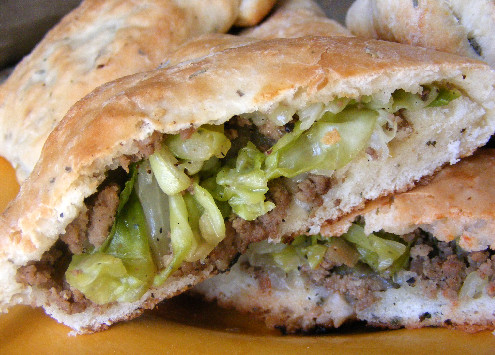
This recipe pays homage to my Nebraska roots . . . When you think about the state, what first comes to mind? For most it’s corn, Big Red football and Omaha Steaks®. Now, after you read this post, you’ll be adding cabbage burgers to the list.
They are individual-sized, savory yeast bread stuffed with peppered beef, cabbage and onions; baked golden brown. Simple ingredients and spices that make for a comforting, satisfying meal. For those not in on these little treasures, think calzone, empanada or pierogi rather than a typical burger. In Nebraska, they are also called cabbage buns or runzas; in Kansas, bierocks.
At the turn of the nineteenth century, cabbage burgers were introduced to the mid-west by German Russians (Volga Germans) who immigrated to the U.S. and settled primarily along the plains of Nebraska and Kansas. Since then, they have been notable, regional fare. Runza®, a Nebraska fast-food franchise, serves them up in a variety of flavors.
Growing up, my Mexican family ate plenty. I suspect it’s because the pillowy treats provide a good way to stretch a pound of ground beef. When my mom baked a batch, they were heavier on the cabbage than beef. I still like ‘em like that. No surprise, I’m a big fan of cabbage – raw and cooked. This recipe comes from the bread maker in my family, my sister Monica.
All you Huskers, I expect a shout out on this one. Leave a comment about how you eat your cabbage burgers.
Tidbits on Cabbage:
- Cabbage belongs to the Cruciferae family of vegetables along with kale, broccoli, collards and brussels sprouts. There are an estimated 100 different varieties of cabbage grown in the world. The most common types in the U.S., however, are the green, red, savoy and Chinese varieties – bok choy and napa.
- Cabbage is estimated to have been cultivated more than 4,000 years and domesticated for over 2,500 years. It is believed to have originated from wild loose-leaf cabbage brought to Europe around 600 B.C. by groups of Celtic wanderers. Since it is a cool weather crop and stores well during winter, it soon became a major crop in Europe – particularly in Germany, Poland and Russia.
- Cabbage has several health benefits: phytonutrients in cabbage and other crucifers help the body detoxify; cabbage is an excellent source of vitamin C, as well as good source fiber, manganese, folate, vitamin B6, potassium and omega-3 fatty acids.
- Since phytonutrients react with carbon steel and turn cabbage leaves black, use a stainless steel knife to cut.
(more…)
Print & If you liked this post, please share:
Tags: bierock, cabbage burger, German, kansas, nebraska, recipe, runza
Posted in Cabbage, German, Ground Beef, Main, Side | 31 Comments »
Friday, October 30th, 2009
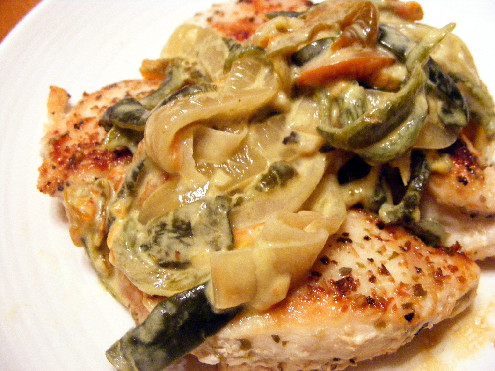
This recipe is for all you cream sauce lovers. Rajas con crema is a winner – smoky, spicy chiles rounded by a simple rich cream sauce. And, it’s super easy to make, especially if you cheat and get your chiles pre-roasted.
The inspiration for this recipe came last month when I went to my friend Laura’s annual Mexican Independence potluck pachanga (party). That night I made my way to the food line one time too many – each time scooping a spoonful of rajas. Rajas con crema, literally translates to mean “slices with cream.” Aesthetically, it was the perfect dish for her party representing the colors of the Mexican flag, green and red from the roasted chiles and white from the onion. Gastronomically, it was scrumptious.
Here’s my version of rajas con crema using crema Mexicana, Mexican cream, to give it richness. It is thick and slightly acidic, definitely more decadent than regular sour cream.
I used roasted poblano chiles and, just to be sure it had enough kick, I also used a couple of roasted hot Hatch chiles. The ultimate result is a spicy creamy combo that is sure to please, either as vegetarian taco filling, a side with rice and beans or served on top of grilled chicken or steak (as pictured above).
Tidbits on Chile
- Chiles are believed to have originated in South America in an area bordered by the mountains of Brazil and Bolivia.
- Chile peppers are the most popular spice and condiment in the world, consumed daily by one-quarter of the world’s population.
- Raw green chile has more vitamin C than citrus fruits.
- Chile heat levels (capsaicin) is determined by a plant’s variety and the environment where it grows. The amount of capsaicin will increase under dry, stressful conditions.
Sources: Encyclopedia of Food and Culture and the Chile Pepper Institute of the University of New Mexico.
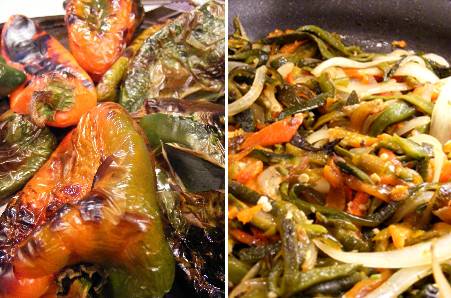
(more…)
Print & If you liked this post, please share:
Posted in Chicken, Chile, Cream, easy, Green Chile, Mexican, Side, Vegetarian | 15 Comments »
Monday, October 19th, 2009
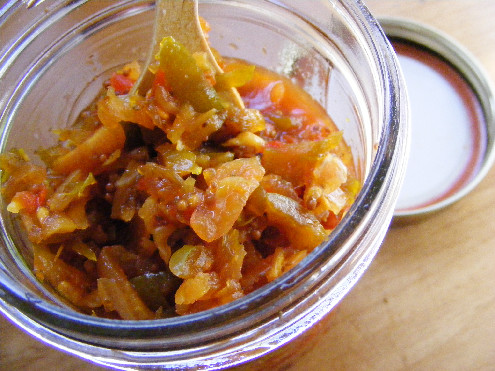
I confess that even though I lived in the South (Austin, Texas) for several years and am married to a brotha, I’d never eaten chow chow until last summer. Chow chow, also called “cha cha” or “piccalilly” in some parts, is a pickled relish of chopped vegetables that has its origins in Southern fare and Soul Food. As with the name, there are many variations of the relish but nearly all contain green tomatoes, cabbage, onions and peppers.
All you gardeners, who salvaged your summer veggies before the freeze and now have green tomatoes laying about willy-nilly, should give this recipe a go.
For this recipe, I got some direction from my friend Tony, a man of many talents – artist, athlete, handy-man and cook. He graciously shared a recipe and some of his chow chow. His version is greener, in line with tradition, and it’s sweet (think Southern sweet tea sweet) especially when eaten alone. But, on a burger, it’s delish and a good addition in a marinade for grilled chicken, because the sugar caramelizes nicely.
My version, adapted from Tony’s, is spicier, less sweet and has a reddish hue (I used my garden bounty – red cabbage and more red and yellow bell peppers). It also has a bit of a “wang” because I used Thai and serrano chiles from my garden. Next time I have a hankering for a pickled relish – I’ve got my own.
Tidbits on Green Tomatoes:
- Tomatoes and other nightshade plants like eggplants were grown on Southern plantations decades before acceptance in other colonies or England, according to The Oxford Encyclopedia of Food and Drink in America.
- There’s some debate about the origins of the name “chow chow,” some say it comes from the Mandarin Chinese word cha, which means mixed, and dates back to the 1840s when Chinese laborers worked the railroads in the American West. And, others say it is derived from the French word for cabbage, chou.
(more…)
Print & If you liked this post, please share:
Tags: barbeque, bbq, Cabbage, fall, green tomato, pickled, recipe, relish, summer, vinegar
Posted in Bell Pepper, Cabbage, Condiment, Gluten-free, Side, Soul Food, Southern, Tomato, Vegetarian | 18 Comments »
Sunday, October 11th, 2009
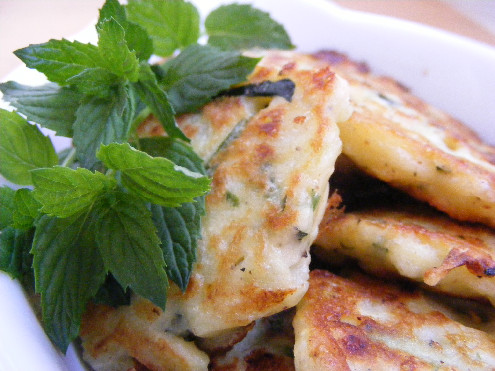
You probably have plenty of recipes that call for zucchini baked, grilled and stewed. I do too. So the first time I tasted a zucchini fritter at a community garden potluck, I was thrilled and inspired to do some research . . . What’s a fritter?
Technically, something that’s coated in a batter and fried. There are a lot of versions out there, most calling for grated zucchini in a batter with some sort of cheese. Personally, I’ve become partial to the Turkish version, Kabak Mucveri, because I really like feta and mint. Kabak Mucveri is typically eaten as a hot or cold appetizer and is served among several fingerfoods as a meze like tapas, but it’s also a great side dish. In Turkish cuisine, vegetables shine.
My version is light but not skimpy on flavor (I ate five the first time I made them). They have a crunchy outside and a flavorful center with the zucchini slightly crisp and bits of sharp feta and refreshing herbs in every bite. I prefer them served hot but they are also yummy at room temperature.
Tidbits – Zucchini:
- Since squash was domesticated in the Americas, most summer squash were introduced to the Old World after 1492, the time of European colonization. To the Romans, squash resembled other cucurbits belonging to other plant species and became integrated into the Mediterranean diet. Squash received the name of “calabash” and in Syria was called “zucco.” From this comes its present-day name, zucchini, according to the Encyclopedia of Food and Culture.
- Squash is now cultivated throughout the Americas, Europe, Africa, the Middle East, China, India, and Indonesia.
- Zucchini has a high water content (95%), which makes the vegetable low in calories – about 25 calories per raw cup and nutritionally contain folate, potassium, and vitamins A and C.
(more…)
Print & If you liked this post, please share:
Tags: fried, garden, herbs, meze, recipe, squash
Posted in By Ingredient, By Origin, By Type, easy, Feta, Middle Eastern, Mint, Side, Vegetarian, Zucchini | 128 Comments »
Wednesday, October 7th, 2009
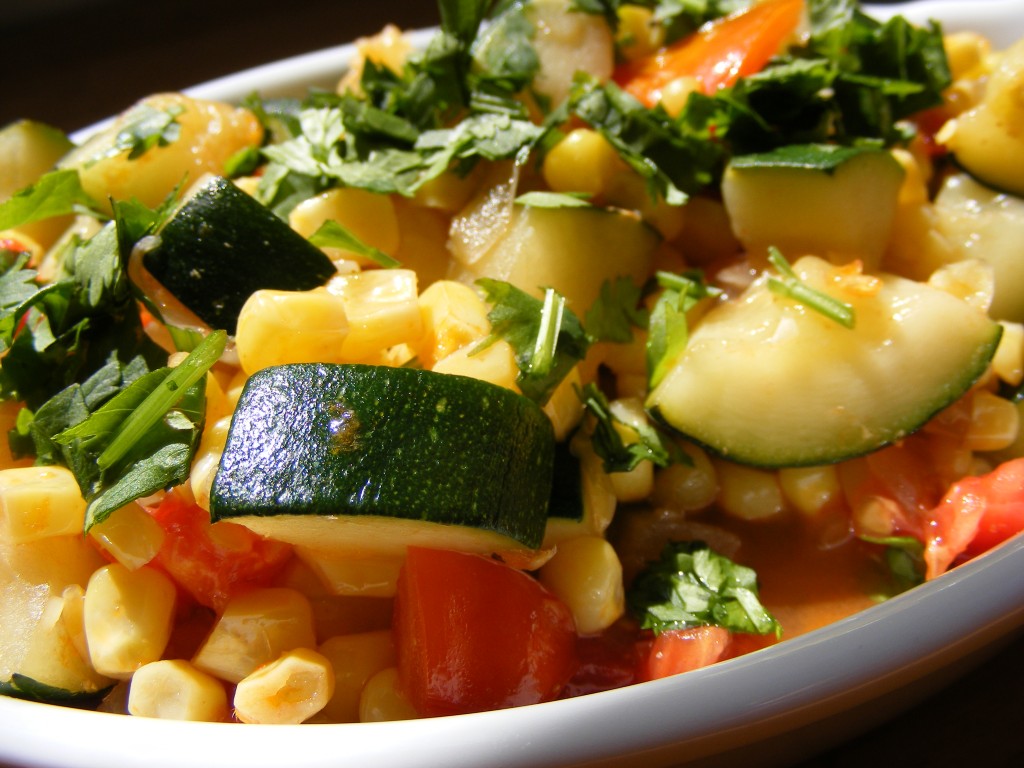
Zucchini? Yes, zucchini. I’m launching my food blog with this humble, under-appreciated summer squash. Why? Because it’s used way, way too much to make stuff like zucchini bread (although I do make my own version). And, some folks are itching for another way to use all those zucchini that proliferate the gardens and markets this time of year. I know what you’re thinking . . . blah. But, you’re wrong. It’s all about how it’s prepared.
In this recipe, the zucchini’s fresh, buttery taste is complimented by crisp corn kernels and the sweet juices of tomato and Mexican seasoning. It’s basically a succotash and it’s been served up in my family and other Mexican kitchens for generations.
This is comfort food more often eaten at home rather than in Mexican restaurants, especially those in the States, where the menu favors greasy, fried tacos over vegetables. This dish is just some of the healthy Mexican food I enjoy and it’s quick and easy to make. Of course there are many variations of calabacitas – some omit the corn, others the tomatoes. I like it with both.
Tidbits on Zucchini:
- Squash was domesticated as early as 10,000 B.P in central Mexico and Peru, as well as other parts of the Americas. As such, squash was an integral staple in Mexican cuisine, along with corn and beans, according to the Encyclopedia of Food and Culture.
- The word calabacita is derived from the Spanish word calabaza, meaning squash; the diminutive “ita” changes the meaning to little squash.
- Zucchini is like the tomato – botanically a fruit but thought to be a veggie.
(more…)
Print & If you liked this post, please share:
Tags: budget, calabacita, comfort food, garden, healthy, Mexican, nutritious, recipe
Posted in Corn, easy, Gluten-free, Mexican, Side, Soup - Stew, Tomato, Vegetarian, Zucchini | 11 Comments »


 Eating black eyed peas on New Year’s Day is a longtime custom among African Americans and Southerners who believe the legumes will bring prosperity and good luck, especially when paired with greens, which symbolize money. Some folks say you just need to eat a spoonful and others say at least 365 (one for each day of the year). Regardless, this year, in this economy, the superstitious dare not skip this tradition.
Eating black eyed peas on New Year’s Day is a longtime custom among African Americans and Southerners who believe the legumes will bring prosperity and good luck, especially when paired with greens, which symbolize money. Some folks say you just need to eat a spoonful and others say at least 365 (one for each day of the year). Regardless, this year, in this economy, the superstitious dare not skip this tradition.





